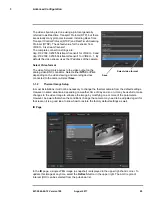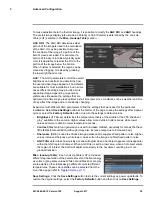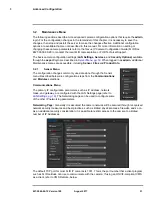
427-0064-00-12 Version 100
August 2017
23
2
Basic Operation and Configuration
2.5
Thermal Imaging Overview
The thermal camera makes an image based on temperature differences. In the thermal image, by
default the hottest item in the scene appears as white and the coldest item is black, and all other
items are represented as a gray scale value between white and black.
Both thermal and daylight cameras have detectors (pixels) that detect energy. One difference
between thermal and daylight cameras has to do with where the energy comes from to create an
image. When viewing an image with a daylight camera, there has to be a source of visible light
(something hot, such as the sun or lights) that reflects light off the objects in the scene. The same is
true with human eyesight; the vast majority of what people see is based on
reflected
light.
The thermal camera, on the other hand, detects energy that
is
directly radiated
from objects in the scene. Most objects
in typical surroundings are not hot enough to radiate visible
light, but they easily radiate energy in the portion of the
infrared spectrum that the camera can detect, the long wave
infrared (LWIR). Even very cold objects, like ice and snow,
radiate this type of energy.
This is why hot objects such as parts on an engines and
exhaust pipes appear white, while the sky, puddles of water
and other cold objects appear dark (or cool)
3
. Scenes with
familiar objects will be easy to interpret with some
experience. The camera automatically optimizes the image to provide the best contrast in most
conditions, and in some cases other settings can be used to further improve the image.
The performance of the camera will likely vary throughout the day. After sunset, objects warmed by
the sun will appear warmest. Early in the morning, many of these objects will appear cooler than their
surroundings, so be sure to look for subtle differences in the scene, as opposed to just hot targets.
2.6
Maintenance and Troubleshooting Tips
If help is needed during the installation process, contact the local FLIR representative, or call the
appropriate support number listed at:
http://www.flir.com/security/display/?id=71083
. FLIR Systems,
Inc. offers a comprehensive selection of training courses to help get the best performance and value
from the thermal imaging camera. Find out more at the FLIR training web page:
http://www.flir.com/
training.
Cleaning
Great care should be used with your camera's optics. They are delicate and can be damaged by
improper cleaning. The FB-Series O thermal camera lenses and windows are designed for a harsh
outdoor environment and have a coating for durability and anti-reflection, but may require cleaning
occasionally. FLIR Systems, Inc. suggests that you clean the lens when image quality degradation is
noticed or excessive contaminant build-up is seen on the lens.
3. By default, the camera represents hot objects as white and cold objects as black. The camera can
be set to use the Black Hot polarity setting, which displays hot objects as black and cold objects as
white and is effectively the negative of White Hot polarity. Refer to
Toggle Polarity, pg. 17
.













































